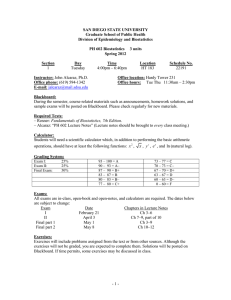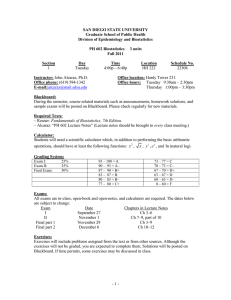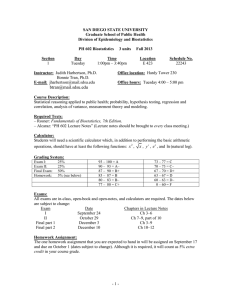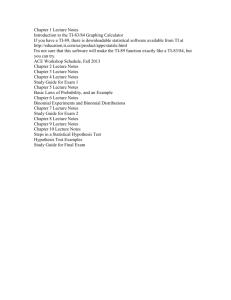SAN DIEGO STATE UNIVERSITY Graduate School of Public Health
advertisement
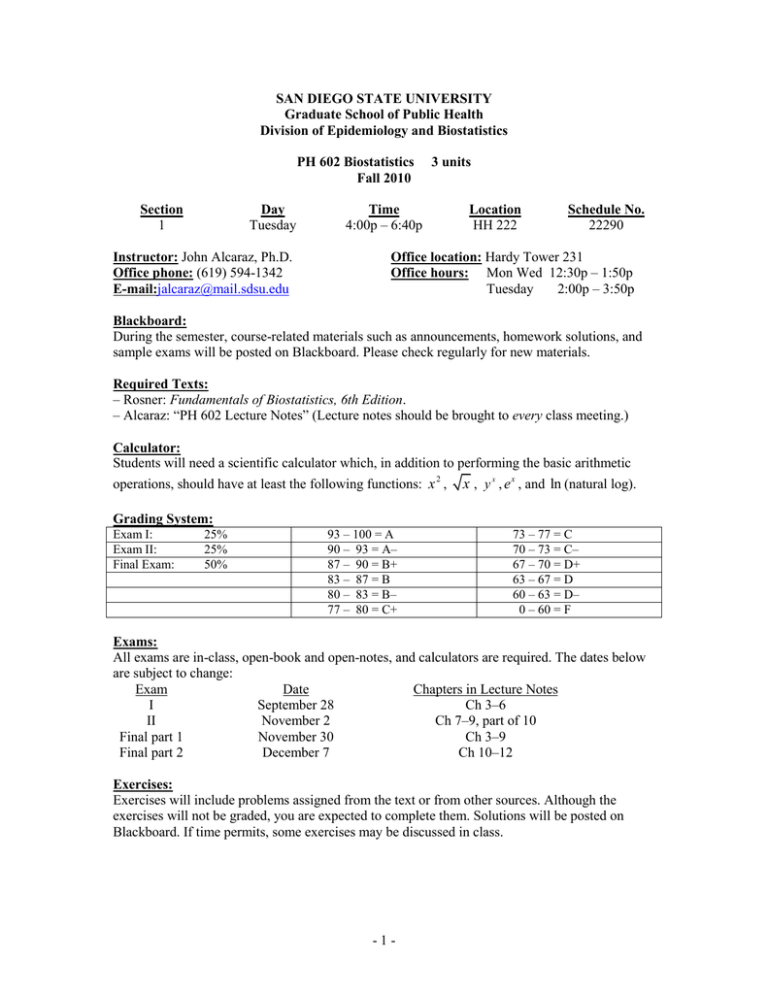
SAN DIEGO STATE UNIVERSITY Graduate School of Public Health Division of Epidemiology and Biostatistics PH 602 Biostatistics Fall 2010 Section 1 Day Tuesday Instructor: John Alcaraz, Ph.D. Office phone: (619) 594-1342 E-mail:jalcaraz@mail.sdsu.edu Time 4:00p – 6:40p 3 units Location HH 222 Schedule No. 22290 Office location: Hardy Tower 231 Office hours: Mon Wed 12:30p – 1:50p Tuesday 2:00p – 3:50p Blackboard: During the semester, course-related materials such as announcements, homework solutions, and sample exams will be posted on Blackboard. Please check regularly for new materials. Required Texts: – Rosner: Fundamentals of Biostatistics, 6th Edition. – Alcaraz: “PH 602 Lecture Notes” (Lecture notes should be brought to every class meeting.) Calculator: Students will need a scientific calculator which, in addition to performing the basic arithmetic operations, should have at least the following functions: x 2 , x , y x , e x , and ln (natural log). Grading System: Exam I: Exam II: Final Exam: 25% 25% 50% 93 – 100 = A 90 – 93 = A– 87 – 90 = B+ 83 – 87 = B 80 – 83 = B– 77 – 80 = C+ 73 – 77 = C 70 – 73 = C– 67 – 70 = D+ 63 – 67 = D 60 – 63 = D– 0 – 60 = F Exams: All exams are in-class, open-book and open-notes, and calculators are required. The dates below are subject to change: Exam Date Chapters in Lecture Notes I September 28 Ch 3–6 II November 2 Ch 7–9, part of 10 Final part 1 November 30 Ch 3–9 Final part 2 December 7 Ch 10–12 Exercises: Exercises will include problems assigned from the text or from other sources. Although the exercises will not be graded, you are expected to complete them. Solutions will be posted on Blackboard. If time permits, some exercises may be discussed in class. -1- Prerequisite: Passing the competency exam in basic statistical methods or successful completion of STAT 119 or STAT 250 or successful completion of an approved basic statistics course within the past three years. Students must complete the prerequisite prior to enrollment. Background: Students are expected to know descriptive statistics (Ch 2, Rosner); this material will not be covered in the course. Students should be familiar with basic concepts of probability (3.1 – 3.6, Rosner), the binomial distribution (4.8 – 4.9), the normal distribution (5.3 – 5.4), basic concepts of estimation (6.1 – 6.3), and basic concepts of hypothesis testing (7.1 – 7.2). These topics will be reviewed in the lectures; however, extensive discussions of this material will not be pursued. Learning Objectives: In this course, students will learn basic biostatistical methods used in biomedical and public health research. Students will be able to recognize and apply the appropriate biostatistical procedures to the analysis of health-related studies. Students will learn 1. To recognize the appropriate use of the binomial, normal, Student’s t, chi-square and F distributions in estimation and hypothesis testing. 2. To describe the relationship between populations and samples, and the crucial role that random sampling plays in statistics. 3. To estimate such parameters as means, variances, and proportions, and to test hypotheses about these parameters (confidence intervals, one-sample test for proportion, one-sample ttest, two-sample t-test, paired t-test). 4. To apply nonparametric tests (Wilcoxon signed-rank test, Wilcoxon rank-sum test) when the underlying distributional assumptions are not met. 5. To assess the association—through relative risk or odds ratio estimation and through hypothesis testing (contingency tables)—between two variables when both variables represent groupings into categories or classes. 6. To understand the appropriate use of simple linear regression and correlation, and to estimate parameters and test hypotheses about linear relationships. 7. To complete a one-way analysis of variance model for comparing three or more means, and to describe procedures for performing multiple pairwise comparisons among these means. -2- Academic Ethics: SDSU has a strict code of ethical conduct which students are expected to follow. Seehttp://csrr.sdsu.edu/conduct1.htmlfor details. In particular, cheating on the exams will not be tolerated. You may not work together on the exams, may not copy answers from other students, and may not allow other students to copy your answers. Anyone caught cheating will face disciplinary action. Attendance/Punctuality: While attendance is not required except for exam dates, students are strongly encouraged to attend every class meeting and to be punctual. On exam dates, the exam will start at 4:00pm sharp and will end at 6:40pm sharp. Those who arrive late on exam dates will not be allowed to work past the end time to complete their exams. If you miss an exam because of severe circumstances (such as illness, injury, death in the family), please contact me no later than one week after the exam to arrange a makeup test. Students for whom an exam falls on a date of religious observance should contact me by the end of the second week of classes to discuss alternative arrangements. Students with Disabilities: Students with disabilities should discuss with me privately any specific accommodations for which they have received authorization. Authorization may be obtained by contacting Student Disability Services at 619-594-6473 (Calpulli Center, Suite 3101). Please obtain authorization before making an appointment to see me. More information can be found at http://www.sa.sdsu.edu/sds/. -3- Course Outline for PH 602 Topic Chapters in Rosner Review of basic concepts of probability Applications of Bayes’ rule 3.1 – 3.6 3.7 Probability distributions Discrete Basic ideas Review of the binomial distribution Continuous Basic ideas Review of the normal distribution Normal approximation to binomial Week * 1 1 5.1, 5.2 5.3, 5.4, 5.5 5.7 1 1 1, 2 2 2 2 2 2, 3 Review of populations and samples Review of random sampling Sampling distribution Estimation: Point and interval 6.1, 6.2 6.3 6.5 6.5, 6.7, 6.8 3 3 3 3 Hypothesis testing Review of basic concepts One-sample problem Two-sample problem Nonparametric statistics Hypothesis tests for categorical data Simple linear regression Correlation Analysis of variance 7.1, 7.2 7.3 – 7.7, 7.9, 7.10 8.1 – 8.7, 8.10 9.1, 9.3, 9.4 10.1 – 10.6, 13.3, 13.5 11.1 – 11.5 11.7, 11.8 12.1 – 12.4 4.1 – 4.7 4.8, 4.9 4 4 4, 6 6 6, 7 7, 8, 9 9 11 11 * Week of the semester (see next page). Timeline is approximate and subject to change. -4- Course Outline for PH 602 Week * 1 Date Aug 31 Topics Basic probability concepts, conditional probability, relative risk, screening tests, discrete random variables 2 Sept 7 Discrete random variables (cont.), binomial distribution, hypothesis testing preview (p-value), continuous random variables, properties of all random variables, normal distribution 3 Sept 14 Normal distribution (cont.), populations and random samples, estimating the mean of a distribution, estimating the variance of a distribution, estimating a binomial proportion 4 Sept 21 Review of hypothesis testing concepts, one-sample z test, onesample t test, one-sample test for binomial proportion 5 Sept 28 Exam I 6 Oct 5 One-sample test for binomial proportion (cont.), paired- versus independent-sample designs, paired t test, two-sample t test, intro to nonparametric tests 7 Oct 12 Wilcoxon signed-rank test, Wilcoxon rank-sum test, chi-square test for 2x2 contingency table 8 Oct 19 Chi-square test for 2x2 contingency table (cont.), Mantel-Haenszel test for 2x2 contingency tables, chi-square test for RxC contingency table, McNemar’s test for paired samples 9 Oct 26 McNemar’s test for paired samples (cont.), simple linear regression 10 Nov 2 Exam II 11 Nov 9 Correlation, overall F test for one-way ANOVA, post-hoc testing (multiple comparisons) 12 Nov 16 Course review (Open Q&A) 13 Nov 23 No class 14 Nov 30 Final Exam part 1 15 Dec 7 Final Exam part 2 * Timeline is approximate and subject to change. -5- Association of Schools of Public Health Core Competencies in Biostatistics BIOSTATISTICS Biostatistics is the development and application of statistical reasoning and methods in addressing, analyzing and solving problems in public health; health care; and biomedical, clinical and population-based research. Competencies: Upon graduation a student with an MPH should be able to… 1. Describe the roles biostatistics serves in the discipline of public health. 2. Describe basic concepts of probability, random variation and commonly used statistical probability distributions. 3. Describe preferred methodological alternatives to commonly used statistical methods when assumptions are not met. 4. Distinguish among the different measurement scales and the implications for selection of statistical methods to be used based on these distinctions. 5. Apply descriptive techniques commonly used to summarize public health data. 6. Apply common statistical methods for inference. 7. Apply descriptive and inferential methodologies according to the type of study design for answering a particular research question. 8. Apply basic informatics techniques with vital statistics and public health records in the description of public health characteristics and in public health research and evaluation. 9. 10. Interpret results of statistical analyses found in public health studies. Develop written and oral presentations based on statistical analyses for both public health professionals and educated lay audiences. Source: ASPH Education Committee, “Master’s Degree in Public Health Core Competency Development Project: Version 2.3,” Association of Schools of Public Health, October 2004August 2006, p. 12<http://www.asph.org/userfiles/version2.3.pdf>. -6-
